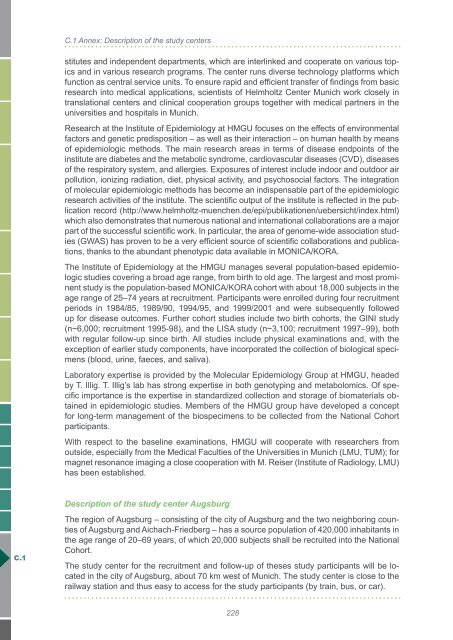Scientific Concept of the National Cohort (status ... - Nationale Kohorte
Scientific Concept of the National Cohort (status ... - Nationale Kohorte
Scientific Concept of the National Cohort (status ... - Nationale Kohorte
Create successful ePaper yourself
Turn your PDF publications into a flip-book with our unique Google optimized e-Paper software.
C.1<br />
C.1 Annex: Description <strong>of</strong> <strong>the</strong> study centers<br />
stitutes and independent departments, which are interlinked and cooperate on various topics<br />
and in various research programs. The center runs diverse technology platforms which<br />
function as central service units. To ensure rapid and efficient transfer <strong>of</strong> findings from basic<br />
research into medical applications, scientists <strong>of</strong> Helmholtz Center Munich work closely in<br />
translational centers and clinical cooperation groups toge<strong>the</strong>r with medical partners in <strong>the</strong><br />
universities and hospitals in Munich.<br />
Research at <strong>the</strong> Institute <strong>of</strong> Epidemiology at HMGU focuses on <strong>the</strong> effects <strong>of</strong> environmental<br />
factors and genetic predisposition – as well as <strong>the</strong>ir interaction – on human health by means<br />
<strong>of</strong> epidemiologic methods. The main research areas in terms <strong>of</strong> disease endpoints <strong>of</strong> <strong>the</strong><br />
institute are diabetes and <strong>the</strong> metabolic syndrome, cardiovascular diseases (CVD), diseases<br />
<strong>of</strong> <strong>the</strong> respiratory system, and allergies. Exposures <strong>of</strong> interest include indoor and outdoor air<br />
pollution, ionizing radiation, diet, physical activity, and psychosocial factors. The integration<br />
<strong>of</strong> molecular epidemiologic methods has become an indispensable part <strong>of</strong> <strong>the</strong> epidemiologic<br />
research activities <strong>of</strong> <strong>the</strong> institute. The scientific output <strong>of</strong> <strong>the</strong> institute is reflected in <strong>the</strong> publication<br />
record (http://www.helmholtz-muenchen.de/epi/publikationen/uebersicht/index.html)<br />
which also demonstrates that numerous national and international collaborations are a major<br />
part <strong>of</strong> <strong>the</strong> successful scientific work. In particular, <strong>the</strong> area <strong>of</strong> genome-wide association studies<br />
(GWAS) has proven to be a very efficient source <strong>of</strong> scientific collaborations and publications,<br />
thanks to <strong>the</strong> abundant phenotypic data available in MONICA/KORA.<br />
The Institute <strong>of</strong> Epidemiology at <strong>the</strong> HMGU manages several population-based epidemiologic<br />
studies covering a broad age range, from birth to old age. The largest and most prominent<br />
study is <strong>the</strong> population-based MONICA/KORA cohort with about 18,000 subjects in <strong>the</strong><br />
age range <strong>of</strong> 25–74 years at recruitment. Participants were enrolled during four recruitment<br />
periods in 1984/85, 1989/90, 1994/95, and 1999/2001 and were subsequently followed<br />
up for disease outcomes. Fur<strong>the</strong>r cohort studies include two birth cohorts, <strong>the</strong> GINI study<br />
(n~6,000; recruitment 1995-98), and <strong>the</strong> LISA study (n~3,100; recruitment 1997–99), both<br />
with regular follow-up since birth. All studies include physical examinations and, with <strong>the</strong><br />
exception <strong>of</strong> earlier study components, have incorporated <strong>the</strong> collection <strong>of</strong> biological specimens<br />
(blood, urine, faeces, and saliva).<br />
Laboratory expertise is provided by <strong>the</strong> Molecular Epidemiology Group at HMGU, headed<br />
by T. Illig. T. Illig’s lab has strong expertise in both genotyping and metabolomics. Of specific<br />
importance is <strong>the</strong> expertise in standardized collection and storage <strong>of</strong> biomaterials obtained<br />
in epidemiologic studies. Members <strong>of</strong> <strong>the</strong> HMGU group have developed a concept<br />
for long-term management <strong>of</strong> <strong>the</strong> biospecimens to be collected from <strong>the</strong> <strong>National</strong> <strong>Cohort</strong><br />
participants.<br />
With respect to <strong>the</strong> baseline examinations, HMGU will cooperate with researchers from<br />
outside, especially from <strong>the</strong> Medical Faculties <strong>of</strong> <strong>the</strong> Universities in Munich (LMU, TUM); for<br />
magnet resonance imaging a close cooperation with M. Reiser (Institute <strong>of</strong> Radiology, LMU)<br />
has been established.<br />
Description <strong>of</strong> <strong>the</strong> study center Augsburg<br />
The region <strong>of</strong> Augsburg – consisting <strong>of</strong> <strong>the</strong> city <strong>of</strong> Augsburg and <strong>the</strong> two neighboring counties<br />
<strong>of</strong> Augsburg and Aichach-Friedberg – has a source population <strong>of</strong> 420,000 inhabitants in<br />
<strong>the</strong> age range <strong>of</strong> 20–69 years, <strong>of</strong> which 20,000 subjects shall be recruited into <strong>the</strong> <strong>National</strong><br />
<strong>Cohort</strong>.<br />
The study center for <strong>the</strong> recruitment and follow-up <strong>of</strong> <strong>the</strong>ses study participants will be located<br />
in <strong>the</strong> city <strong>of</strong> Augsburg, about 70 km west <strong>of</strong> Munich. The study center is close to <strong>the</strong><br />
railway station and thus easy to access for <strong>the</strong> study participants (by train, bus, or car).<br />
228



